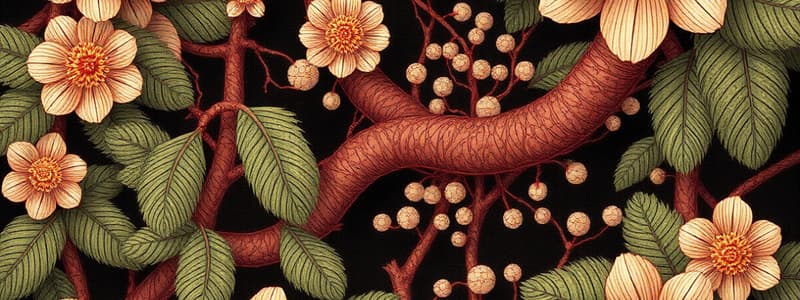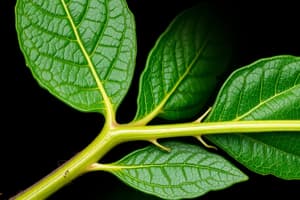Podcast
Questions and Answers
Which of the following describes the primary function of xylem tissue in plants?
Which of the following describes the primary function of xylem tissue in plants?
- Transporting sugars from the leaves to other parts of the plant.
- Providing a protective outer layer for the plant.
- Performing photosynthesis within the stem.
- Transporting water and minerals from the roots to the leaves. (correct)
How do guard cells contribute to the process of photosynthesis in plants?
How do guard cells contribute to the process of photosynthesis in plants?
- By providing structural support to the leaf.
- By directly absorbing sunlight within the leaf.
- By transporting water from the roots to the leaves.
- By regulating the opening and closing of stomata for gas exchange. (correct)
What is the key difference between sexual and asexual reproduction in plants?
What is the key difference between sexual and asexual reproduction in plants?
- Sexual reproduction involves the fusion of gametes, while asexual reproduction does not. (correct)
- Sexual reproduction results in offspring genetically identical to the parent, while asexual reproduction produces genetically diverse offspring.
- Sexual reproduction relies on wind or water for seed dispersal, while asexual reproduction relies on animal vectors.
- Sexual reproduction occurs only in angiosperms, while asexual reproduction occurs only in gymnosperms.
In what way do plants in dry environments adapt to conserve water?
In what way do plants in dry environments adapt to conserve water?
What is the role of mitochondria in plant cells?
What is the role of mitochondria in plant cells?
Which group of plants is characterized by producing seeds in cones?
Which group of plants is characterized by producing seeds in cones?
How does phototropism benefit plants?
How does phototropism benefit plants?
What distinguishes a taproot system from a fibrous root system?
What distinguishes a taproot system from a fibrous root system?
In the process of photosynthesis, what are the primary inputs and outputs?
In the process of photosynthesis, what are the primary inputs and outputs?
Which of the following best describes the role of pholem in plant physiology?
Which of the following best describes the role of pholem in plant physiology?
Flashcards
Plant Cells
Plant Cells
Eukaryotic cells with a cell wall, chloroplasts, and a large central vacuole that provide structure, carry out photosynthesis, and store water/nutrients.
Plant Tissues
Plant Tissues
Outer protective layer; transports water, nutrients, and sugars; performs photosynthesis, storage, and support.
Roots
Roots
Anchors a plant, absorbs water/nutrients from the soil, and stores food.
Stems
Stems
Signup and view all the flashcards
Leaves
Leaves
Signup and view all the flashcards
Photosynthesis
Photosynthesis
Signup and view all the flashcards
Respiration (Plants)
Respiration (Plants)
Signup and view all the flashcards
Plant Reproduction
Plant Reproduction
Signup and view all the flashcards
Plant Adaptations
Plant Adaptations
Signup and view all the flashcards
Main Groups of Plants
Main Groups of Plants
Signup and view all the flashcards
Study Notes
- Plants are complex organisms with cells, tissues, and organs
- Plant cells are eukaryotic, with a nucleus and organelles
- Plant tissues include dermal, vascular, and ground tissue
- Plant organs include roots, stems, and leaves
Plant Cells
- The basic unit of structure and function in a plant is the cell
- Plant cells have a cell wall, chloroplasts, and a large central vacuole
- The cell wall provides support and protection
- Chloroplasts are the sites of photosynthesis
- The large central vacuole stores water, nutrients, and waste
Plant Tissues
- Dermal tissue is the outer protective layer of a plant
- Vascular tissue transports water, nutrients, and sugars throughout the plant
- Xylem transports water and minerals from the roots to the leaves
- Phloem transports sugars from the leaves to the rest of the plant
- Ground tissue is the tissue between the dermal and vascular tissue
- Ground tissue performs various functions, including photosynthesis, storage, and support
Plant Organs: Roots
- Roots anchor the plant in the ground
- Roots absorb water and nutrients from the soil
- Roots store food
- There are two main types of root systems: taproot and fibrous root
- A taproot system has one large main root with smaller roots branching off
- A fibrous root system has many small roots that spread out
Plant Organs: Stems
- Stems provide support for the plant
- Stems transport water, nutrients, and sugars between the roots and leaves
- Stems store food
- Stems can be herbaceous or woody
- Herbaceous stems are soft and green
- Woody stems are hard and rigid
Plant Organs: Leaves
- Leaves are the primary site of photosynthesis in plants
- Leaves have a large surface area to capture sunlight
- Leaves have openings called stomata that allow for gas exchange
- The stomata are surrounded by guard cells that regulate their opening and closing
- Leaves can be simple or compound
- A simple leaf has one blade
- A compound leaf has multiple blades
Photosynthesis
- Photosynthesis is the process by which plants convert light energy into chemical energy
- Photosynthesis occurs in the chloroplasts
- Photosynthesis requires water, carbon dioxide, and sunlight
- During photosynthesis, water and carbon dioxide are converted into sugar and oxygen
- The oxygen is released into the atmosphere
- The sugar is used by the plant for energy and growth
Respiration
- Respiration is the process by which plants break down sugar to release energy
- Respiration occurs in the mitochondria
- Respiration requires sugar and oxygen
- During respiration, sugar and oxygen are converted into carbon dioxide, water, and energy
- The energy is used by the plant for its life processes
Plant Reproduction
- Plants can reproduce sexually or asexually
- Sexual reproduction involves the fusion of sperm and egg cells
- Asexual reproduction involves the production of new plants from existing plant parts
- Flowers are the reproductive organs of plants
- Flowers contain the male and female reproductive structures
- The male reproductive structure is the stamen, which produces pollen
- The female reproductive structure is the pistil, which contains the ovary
- Pollination is the transfer of pollen from the stamen to the pistil
- Fertilization occurs when the sperm cell in the pollen unites with the egg cell in the ovary
- After fertilization, the ovary develops into a fruit, which contains the seeds
- Seeds are dispersed by wind, water, or animals
- Asexual reproduction can occur through vegetative propagation, such as cuttings, grafting, or budding
Plant Adaptations
- Plants have adaptations that allow them to survive in different environments
- Plants in dry environments have adaptations to conserve water, such as deep roots, small leaves, and thick cuticles
- Plants in wet environments have adaptations to deal with excess water, such as air spaces in their roots and leaves
- Plants in cold environments have adaptations to survive freezing temperatures, such as dormancy and antifreeze proteins
Plant Classification
- Plants are classified into different groups based on their characteristics
- The main groups of plants include: mosses, ferns, gymnosperms, and angiosperms
- Mosses are nonvascular plants that lack true roots, stems, and leaves
- Ferns are vascular plants that reproduce using spores
- Gymnosperms are vascular plants that produce seeds in cones
- Angiosperms are vascular plants that produce seeds in flowers and fruits
- Angiosperms are the most diverse group of plants
Plant Growth and Development
- Plant growth and development are influenced by internal and external factors
- Internal factors include genes and hormones
- External factors include light, temperature, water, and nutrients
- Plant hormones regulate various aspects of plant growth and development, such as cell division, cell elongation, and flowering
- Tropisms are plant responses to external stimuli, such as light, gravity, and touch
- Phototropism is the growth of a plant towards light
- Gravitropism is the growth of a plant in response to gravity
- Thigmotropism is the growth of a plant in response to touch
Importance of Plants
- Plants are essential for life on Earth
- Plants produce oxygen, which is necessary for animals to breathe
- Plants provide food for humans and other animals
- Plants provide shelter and habitat for many animals
- Plants are used to make medicines, building materials, and other products
- Plants play an important role in the environment, helping to regulate the climate and prevent soil erosion
Studying That Suits You
Use AI to generate personalized quizzes and flashcards to suit your learning preferences.





